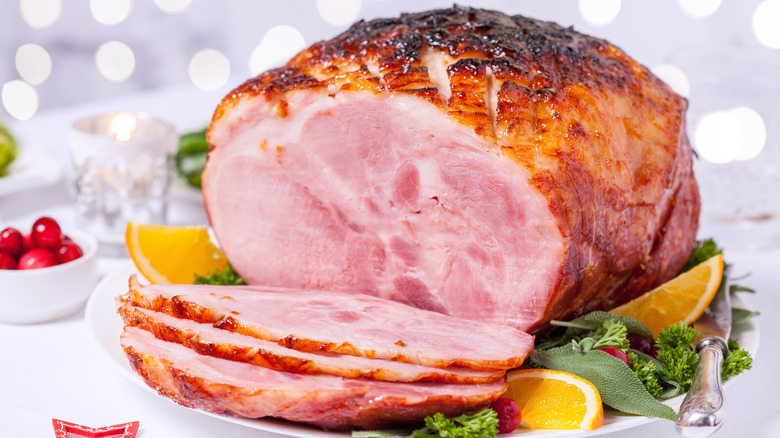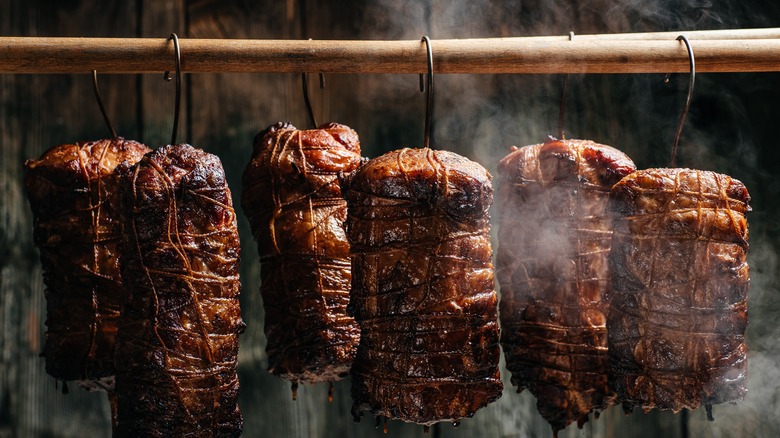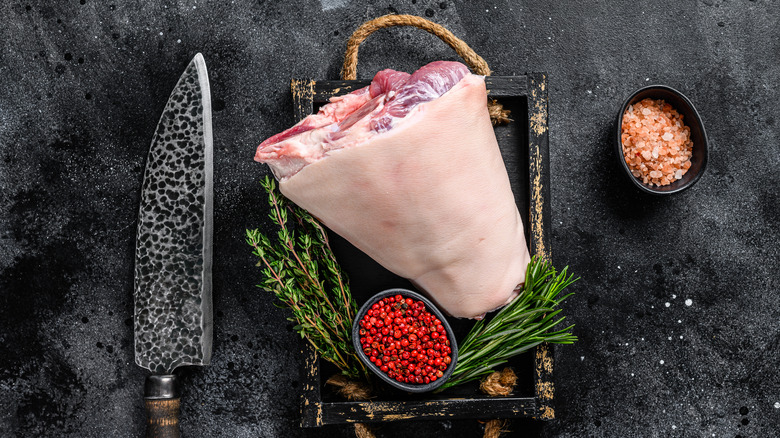What's Unique About Irish Ham?
Ham is an important food product all over the world. All hams start out the same way: they are taken from the hind leg of a hog, and in this sense, hams are really just pork roasts. In order to become the ingredient we know as ham, the roast is taken through a series of aging, curing, smoking, cooking, brining or a combination of any of these methods. For example, a pork roast that is flavored with juniper, garlic, herbs, and pepper before being cold-smoked will become German Black Forest ham. A roast made from a white breeding pig in Parma, Italy (which will be aged for a little over a year) will become a Prosciutto di Parma (via Jamonify).
In America, eating ham is nothing new, particularly in our lunch sandwiches, which typically utilize boiled, un-smoked ham, and around holidays when a baked ham is often the centerpiece of the meal. Since the popularity explosion of charcuterie boards, Americans have taken a larger interest in cured European hams as well, such as Spanish Serrano ham and Italian Speck. Indeed, our affinity for pork has never been higher. Prized, higher-priced hams, most of which come from Spain, usually come from specific breeds of pigs that are fed a certain diet and are aged sometimes for years. But one of the most cherished international hams actually comes from Ireland, a country more equated with soda bread and colcannon than ham.
How Irish ham is made
Irish ham is not dry-cured like many of the paper-thin-sliced Spanish and Italian hams so prevalent in wine bars and cocktail parties. Rather, Irish hams are first brined or pickled in liquid (also known as wet-curing) for days at a time. The whole ham is then smoked over either peat moss or juniper, which gives Irish ham a distinct flavor that can sometimes be described as piney and smoky, per Delighted Cooking. Similar to the way Smithfield hams hail from Smithfield, Virginia, Irish hams tend to be made in Belfast or Limerick, Ireland.
Traditionally, whole Irish hams soak overnight before they are cooked in order to tame the high salt content and flavor. Traditional, salty brined hams must go through a vigorous, labor-intensive process before they are eaten, including a long soak, a scrub, a simmer in water, and finally, a bake in the oven. But The Irish Times explains that consumer tastes are changing and that a high salt content isn't as desirable as it once was, so some Irish ham purveyors like Oliver Carty & Family are turning out hams that don't need to be soaked at all before being cooked in the oven.
How are Irish hams different from others?
Placed side by side with other whole hams, an Irish ham may look like any other type, but there are some significant differences. Many times, American shoppers can purchase a ham that has been fully seasoned and pre-cooked; all they need to do is warm it up in the oven before serving, or even eat it cold. You don't want to do this with Irish ham, which requires baking before consuming. In this way, it is similar to Virginia Smithfield hams. The wet-curing process for Irish hams contrasts with any ham that has gone through a dry-cured method like Prosciutto di Parma and Jamón Iberico. While Irish hams are soaked in a liquid brine and then smoked, dry-cured hams are packed in salt and stored until they are cured.
In America, many ham recipes include sweet glazes that include things like brown sugar or marmalade, but many Irish ham recipes suggest foregoing the sweet ham glazes for savory ones. These sometimes include alcohol like beer or whiskey and mustard. Tradition or not, if sweet is your thing, go for it, as the contrast between something sweeter and the smokiness of the ham will still be delicious.
Where to get Irish ham
As the name suggests, authentic Irish hams only come from Ireland, so you're likely to only find one in a well-stocked specialty market that has imported theirs from Ireland or the U.K. You can also order Irish hams online from a company that sells imported Irish foods. Delighted Cooking also suggests getting to know your local butcher and asking if one can be ordered for you. If the task of getting your hands on one proves to be impossible, the outlet explains that many country-style hams would be a suitable substitute because they are generally prepared in ways that are similar to Irish ham preparation. Unfortunately, you may not get that distinct flavor of peat smoke or juniper berry that sets Irish hams apart, but country-style hams are also brined and need to be fully cooked, so you should get that salty ham flavor you are looking for.
Once cooked, Delighted Cooking suggests serving it in thin slices because of its higher salt content, alongside your favorite side dishes. Northern Ireland's Pheasants' Hill Farm notes that if you'd rather serve your ham cold – which is popular to do for a Boxing Day buffet – fully cook it first, then chill it in the refrigerator before serving.



